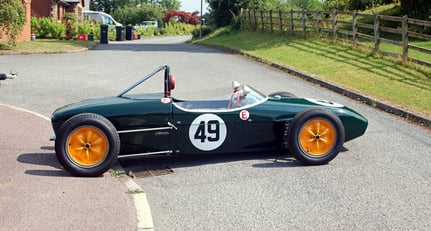1960 Lotus 18
Chichester, 14 September
Lot sold
USD 37 813 - 50 417
GBP 30 000 - 40 000 (listed)
Estimate
USD 37 813 - 50 417
GBP 30 000 - 40 000 (listed)
-
Year of manufacture1960
-
Chassis number18-J-816
-
Engine number105E 63268
-
DriveLHD
-
ConditionUsed
-
Number of seats2
-
Location

-
Exterior colourOther
-
Drivetrain2wd
-
Fuel typePetrol
Description
1960 Lotus Type 18 Formula Junior Monoposto
Chassis no. 18-J-816
Engine no. 105E 63268
'I always regard the Lotus 18 as my first Grand Prix design... forget the earlier front-engined cars, the Lotus 16s, they were really Formula 2 designs stretched for Formula 1. As far as I am concerned when they kept breaking we eventually threw the whole bunch of ingredients up in the air and started again and the result was the 18, and it started winning...' Colin Chapman. Introduced for the 1960 season, the Type 18 was Lotus's first mid-engined Grand Prix car design. 1960 was the last year of the 2½-Litre Formula 1 and the Lotus 18 won that year's Monaco Grand Prix, driven by Stirling Moss. The same car/driver combination triumphed again at Monte Carlo the following year, the first of the 1½-Litre Formula 1, and the highly versatile Type 18 would prove adaptable to both Formula 2 and Formula Junior applications. As its name so aptly suggested, Formula Junior was the main 'feeder' racing class for Formula 1 and other more senior forms of motor sport in the early 1960s. The spaceframe Type 18 was Lotus's first foray into this hotly contested series. Almost invariably fitted with a Cosworth-modified Ford 105E engine, it proved to be the class of the field, Team Lotus works drivers Jim Clark and Trevor Taylor dominating the 1960 season. One of 125 Lotus 18s produced, chassis number '18-J-816' was exported to North America in October 1960 destined for Lotus agent Jay Chamberlain. Reputedly, but not proven, it was one of six sold to Pedro Rodriguez for his racing school. Nothing is known about its life in the USA prior to its restoration by New England Classics in 200/2001, following which it was placed on museum display. The current vendor, Editor of the Historic Lotus Register magazine, imported the car from a US car museum (all taxes paid) and brought it back to the UK in October 2004. Cosmetically it was excellent but the vendor soon replaced the brake wheel cylinders and flexible brake pipes, while the 997cc Cosworth Ford engine was dismantled and rebuilt with a reground crankshaft and new bearing shells, and new oil, water and fuel pumps (see photographs on file). The Renault close-ratio gearbox was next, undergoing a full overhaul and the fitting of a FJ replacement stronger main shaft, together with a new AP clutch cover and plate. On the suspension side, the springs and shock absorbers were replaced and new radius rods made. Other changes (roll-over bar, fire bottle, safety belts, rain light) have been made to satisfy current FIA regulations. The new Dunlop tyres have done one practice session at Mallory Park. One of 72 Lotus 18s registered with Historic Formula Junior Association, '18-J-816' has British HTP papers and is known and accepted by the Association's Duncan Rabagliati. It would run in the Class Cl FIA Category FJ/1C for rear-engined Formula Junior cars built and raced (or officially entered to race) before 31st December 1960 and fitted with engines of 1,000cc or less. In short: this is a highly original, wet sump, drum-braked, Renault gearbox car, and as such is running to correct period specification. We are advised that it is circuit race-ready apart from the fire bottle and fuel cell, which would have to be replaced. Nevertheless, the car as it stands is ready for UK hill climbs, complete with small alloy fuel tank, while the fire bottle is acceptable. The original fuel tank is present but out of use. Little used since the rebuild, this potentially competitive Lotus 18 Formula Junior is offered with restoration invoices and the aforementioned FIA papers.
Chassis no. 18-J-816
Engine no. 105E 63268
'I always regard the Lotus 18 as my first Grand Prix design... forget the earlier front-engined cars, the Lotus 16s, they were really Formula 2 designs stretched for Formula 1. As far as I am concerned when they kept breaking we eventually threw the whole bunch of ingredients up in the air and started again and the result was the 18, and it started winning...' Colin Chapman. Introduced for the 1960 season, the Type 18 was Lotus's first mid-engined Grand Prix car design. 1960 was the last year of the 2½-Litre Formula 1 and the Lotus 18 won that year's Monaco Grand Prix, driven by Stirling Moss. The same car/driver combination triumphed again at Monte Carlo the following year, the first of the 1½-Litre Formula 1, and the highly versatile Type 18 would prove adaptable to both Formula 2 and Formula Junior applications. As its name so aptly suggested, Formula Junior was the main 'feeder' racing class for Formula 1 and other more senior forms of motor sport in the early 1960s. The spaceframe Type 18 was Lotus's first foray into this hotly contested series. Almost invariably fitted with a Cosworth-modified Ford 105E engine, it proved to be the class of the field, Team Lotus works drivers Jim Clark and Trevor Taylor dominating the 1960 season. One of 125 Lotus 18s produced, chassis number '18-J-816' was exported to North America in October 1960 destined for Lotus agent Jay Chamberlain. Reputedly, but not proven, it was one of six sold to Pedro Rodriguez for his racing school. Nothing is known about its life in the USA prior to its restoration by New England Classics in 200/2001, following which it was placed on museum display. The current vendor, Editor of the Historic Lotus Register magazine, imported the car from a US car museum (all taxes paid) and brought it back to the UK in October 2004. Cosmetically it was excellent but the vendor soon replaced the brake wheel cylinders and flexible brake pipes, while the 997cc Cosworth Ford engine was dismantled and rebuilt with a reground crankshaft and new bearing shells, and new oil, water and fuel pumps (see photographs on file). The Renault close-ratio gearbox was next, undergoing a full overhaul and the fitting of a FJ replacement stronger main shaft, together with a new AP clutch cover and plate. On the suspension side, the springs and shock absorbers were replaced and new radius rods made. Other changes (roll-over bar, fire bottle, safety belts, rain light) have been made to satisfy current FIA regulations. The new Dunlop tyres have done one practice session at Mallory Park. One of 72 Lotus 18s registered with Historic Formula Junior Association, '18-J-816' has British HTP papers and is known and accepted by the Association's Duncan Rabagliati. It would run in the Class Cl FIA Category FJ/1C for rear-engined Formula Junior cars built and raced (or officially entered to race) before 31st December 1960 and fitted with engines of 1,000cc or less. In short: this is a highly original, wet sump, drum-braked, Renault gearbox car, and as such is running to correct period specification. We are advised that it is circuit race-ready apart from the fire bottle and fuel cell, which would have to be replaced. Nevertheless, the car as it stands is ready for UK hill climbs, complete with small alloy fuel tank, while the fire bottle is acceptable. The original fuel tank is present but out of use. Little used since the rebuild, this potentially competitive Lotus 18 Formula Junior is offered with restoration invoices and the aforementioned FIA papers.

Bonhams 1793
101 New Bond Street
London
W1S 1SR
Contact Person
Kontaktperson
First name
Bonhams Collectors’ Car department
Phone
+44-2074685801
Fax
+44-2074477401
























